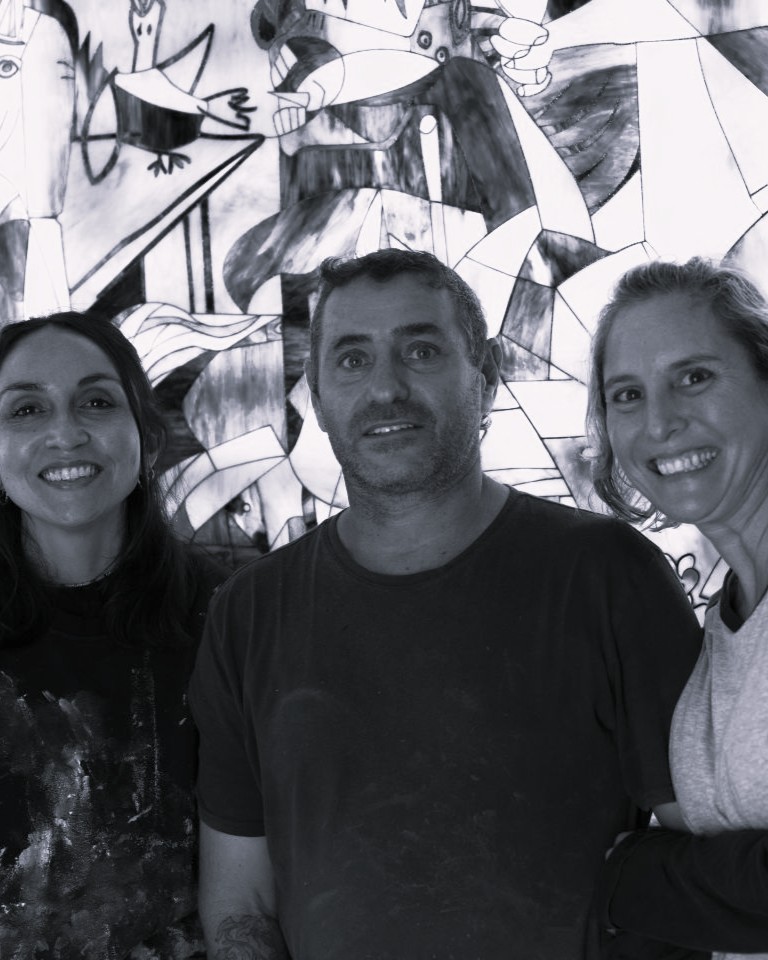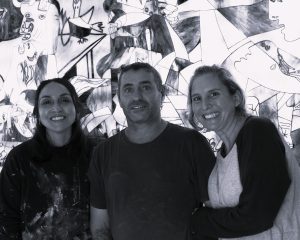
Mauricio Aybar, Andrea Castiglione & Tamara Silva

Andrea Castiglione is a Helensvale-based mosaic artist and Project Art Manager celebrated for her innovative large-scale public art installations. Her work combines traditional mosaic techniques with modern design, earning awards such as the Best Luxury Artwork in Australia and the Best Mosaic Artistic Artwork Studio.
In collaboration with Mauricio Aybar, Andrea creates dynamic and visually striking installations that merge colour, texture, and form to transform public spaces into immersive experiences. Their partnership highlights a shared passion for craftsmanship and creative innovation.As the director of Maurimosaic Art Studio and Artistic Mosaic Designs, Andrea curates exhibitions and mentors emerging artists, fostering community engagement and cultural expression. Her ability to blend artistic vision with meticulous project management has solidified her reputation as a leader in her field.
Andrea’s contributions to the SWELL Sculpture Festival embody her commitment to creating inspiring works that connect people and elevate public art.
Stories to the Wind
‘Stories to the Wind’ is a deeply personal installation by Andrea Castiglione, inspired by the artist’s migration journey. Featuring five vibrant, mosaic-covered posts, the work symbolises community, resilience, and cultural connection. Suspended garments, weathered by the wind, reflect stories of human strength and the bonds that transcend borders. This piece celebrates the shared desire to belong and the beauty found in our differences, inviting viewers to reflect on the universal need for connection and belonging in an ever-changing world.
Artist Interview with Mauricio Aybar
What sparked the idea for the work you are exhibiting at SWELL this year?
‘Stories to the Wind’ was sparked by my personal journey of migration and the emotional landscapes that come with leaving one place and creating a new sense of home. The work emerged from a desire to honour the strength and resilience of those who cross borders — not just physically, but emotionally and culturally. The wind became a powerful symbol: ever-changing, borderless, and able to carry stories across time and space. Through the suspended garments and mosaic-covered posts, the piece reflects on identity, memory, and the way communities are shaped by shared experiences and the universal longing to belong.
What’s something people might not realise about the process behind your work?
What many people might not realise is how physically and emotionally intensive the process is. Each mosaic piece is cut, shaped, and placed by hand — a meditative and time-consuming practice that requires precision, patience, and vision. Beyond the technical labour, there’s also a deeply personal layer: every element carries symbolic meaning, often drawn from lived experience, memory, or cultural references. The suspended garments, for example, were carefully selected and weathered naturally to echo the passage of time and human resilience. It’s not just an artwork — it’s a process of storytelling in fragments, assembled slowly with intention and heart.
What role does location or environment play in your sculptures?
Location plays a central role in my work — it’s never just a backdrop, but an active part of the story. For ‘Stories to the Wind’, the coastal environment of Currumbin is essential. The wind, sun, and open sky all interact with the installation, breathing life into the suspended garments and casting ever-changing shadows on the mosaic forms. The natural elements mirror the themes of movement, change, and adaptation that the work explores. Placing the piece in such a dynamic landscape allows the audience to feel the presence of the wind — not just see it — and reflect on how the environment shapes who we are and how we connect.
Is there a moment or memory that shaped you as an artist?
One defining moment that shaped me as an artist was arriving in Australia as a migrant, carrying just a few personal belongings and a head full of memories. I remember standing by the ocean, feeling both lost and hopeful — the vastness of the sea reflecting the uncertainty ahead. That experience made me realise how powerful art could be in processing identity, grief, and transformation. It pushed me to create works that honour not just my own journey, but the shared stories of migration, resilience, and cultural connection. That moment by the water is something I carry into every piece I make.
What keeps you coming back to sculpture as a form of expression?
Sculpture allows me to turn emotions into physical form — to give weight, texture, and presence to things we often can’t see, like memory, identity, or belonging. It’s a way of creating something that lives in space, that people can walk around, feel the shadows of, or even hear move with the wind. I keep returning to sculpture because it invites connection — it exists in the real world, not behind glass. With every piece, I’m not just telling a story — I’m building a place for others to find their own meaning, to reflect, and to feel seen.
If you could install your work anywhere in the world, where would it be and why?
If I could install ‘Stories to the Wind’ anywhere, it would be along a coastal migration path — perhaps on the shores of the Mediterranean, where so many journeys begin or end. That landscape holds so many layered stories of hope, loss, displacement, and resilience. Placing the work there would allow it to resonate with those very real human experiences, acting almost like a silent monument to the countless lives shaped by movement. It would also connect with the wind in a different way — carrying stories not only across landscapes, but across cultures and generations.
Instagram @artisticmosaicdesigns
Come and see for yourself at SWELL Sculpture Festival, Pacific Parade, Currumbin 12th – 21st September.
